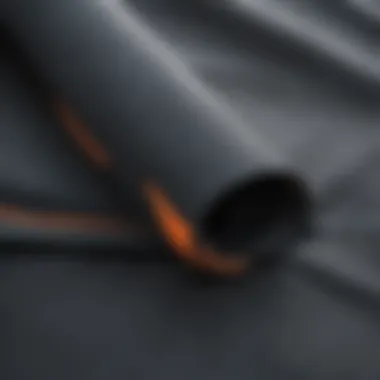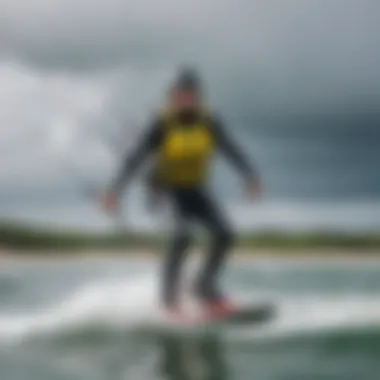Softshell vs. Hardshell: Choosing Your Kiteboarding Gear


Intro
Kiteboarding is not just a sport; it's a way of life for many who seek adventure and freedom in the vastness of oceans and lakes. When gearing up for this exhilarating experience, the choice of materials for clothing and equipment can make a significant difference in performance and comfort. This article brings into focus the head-to-head competition between softshell and hardshell materials used in kiteboarding gear. As racers cut through the water or soar through the sky, understanding the attributes of these materials gives both novice and seasoned kiteboarders the edge they need to enjoy their sport, regardless of the weather.
From flexibility and weight to breathability and water resistance, this narrative will illuminate the critical factors that anyone should consider before making a purchase. Whether gliding over calm waters or riding the rough waves, the right equipment will influence not only your enjoyment but also your safety on the water.
Let's embark on this in-depth exploration together, breaking down the aspects of softshell and hardshell materials so that kiteboarders can make informed decisions and truly fly high on their next outing.
Prolusion to Kiteboarding Gear
Kiteboarding has gained a strong foothold among adrenaline junkies and beach lovers alike, merging elements of surfing, wakeboarding, and flying. When it comes to ensuring an exhilarating experience on the water, the importance of choosing the right gear can't be overstated. A kiteboarder’s performance often hinges on how well their equipment interacts with their chosen environment, making the selection of materials pivotal.
Importance of Material Selection
The materials that compose kiteboarding gear are more than just a layer of protection; they can make or break a session out on the water. When you’re zipping across the waves, the right fabric can keep you warm, dry, and comfortable while allowing for maximum movement. Conversely, the wrong choice can lead to discomfort and even hinder your performance. It is essential to weigh in factors such as durability, flexibility, and weather resistance.
Kiteboarders encounter a range of weather conditions, from crisp breezes to sudden downpours. Choosing the proper material can mean the difference between a delightful day on the water or a challenging encounter with the elements. Additionally, the aesthetic qualities, such as color and design, also play a role in the selection process, visually appealing gear can enhance the overall experience.
Overview of Softshell and Hardshell
When diving into the specifics of kiteboarding gear, two major material categories stand out: softshell and hardshell. Each boasts its own unique set of characteristics and serves different needs.
- Softshell fabrics are generally flexible, breathable, and designed for comfort. These materials can adapt well to varying body movements, making them ideal for sports where agility is key.
- Hardshell fabrics, on the other hand, are built for durability and protection. They are robust materials that form a barrier against wind and water, often preferred when encountering harsher weather conditions.
Navigating the nuances between softshell and hardshell can seem daunting, but knowing their strengths and weaknesses will provide kiteboarders with the clarity needed to choose the gear that best suits their personal style. As we delve deeper into the characteristics and applications of each material in the upcoming sections, the aim is to empower both novices and seasoned kiteboarders alike to make informed decisions that will enhance their experience on the water.
Understanding Softshell Fabrics
When it comes to kiteboarding gear, understanding softshell fabrics is crucial for anyone who spends more than a few hours on the water. Softshells strike a fascinating balance between comfort and performance. These materials not only provide protection from the elements but also offer flexibility, making them suitable for varied conditions that every kiteboarder faces.
Composition of Softshell Materials
Softshell fabrics are typically crafted from a blend of woven or knitted textiles, often consisting of polyester or nylon mixed with spandex or other types of elastane. This blend aids in achieving a lighter, more breathable fabric. The outer layer is designed to fend off wind and light rain, while the inner lining often features a fleece-like material that enhances warmth and softness.
These materials are engineered not just for their composition but also their finish. Some softshells come with a water-resistant coating, which adds a layer of practicality when you're out on a sudden squall. The catch is, while they repel water, they aren’t meant for heavy downpours. This unique blend of elements sets them apart from other options available in the market.
Breathability and Comfort
One of the standout features of softshell fabrics is their breathability. This characteristic is paramount for kiteboarders because after a vigorous ride, staying dry and comfortable can make a difference between a pleasant experience and a miserable one. Softshells allow moisture from sweat to escape while still providing a barrier against the wind.
This means that even on a hot day, you won't feel like you're cooking inside your gear. Many kiteboarders find that comfort is one of the most underrated aspects of gear selection. With a softshell, you're more likely to enjoy your time in the water, focusing on the thrill of riding instead of fidgeting with uncomfortable clothing.
Flexibility and Range of Motion
Flexibility in kiteboarding gear can not be overstated. The range of motion that softshell fabrics provide is a game changer. Whether you’re performing tricks or simply trying to keep your balance, having the ability to move freely can be a real blessing. Softshell materials stretch, allowing for a more comfortable fit that doesn’t restrict movement.
For instance, many kiteboarders appreciate how softshell jackets or pants hug the body without constraining it. This flexibility can enhance performance, enabling smoother transitions and better overall control. Just imagine whipping around with the wind at your back, feeling that unconfined mobility.
Ideal Use Cases for Softshell Gear
Softshell gear is best suited for a variety of scenarios. Take mild weather conditions, where you face light wind and drizzle. A softshell jacket can keep the chill at bay while allowing for excellent movement.
Moreover, if you’re into freestyle kiteboarding, you'll find softshells particularly advantageous. They provide the necessary protection without weighing you down, which is essential for those tricky maneuvers.
In short, softshell fabrics are intelligent choices for kiteboarders who value comfort and performance over time. Throw in their versatility and you have a fabric that positions itself perfectly within the diverse realm of kiteboarding gear.


Exploring Hardshell Fabrics
Hardshell fabrics are pivotal in the world of kiteboarding gear, serving the crucial role of providing robust protection and durability in various harsh conditions. When the winds whip and the waves crash, you want to feel secure in your gear. This section delves into what makes hardshell materials not just a choice, but a wise investment for kiteboarders. Understanding the composition, water resistance, protective qualities, and contexts in which hardshell gear excels can make all the difference in your kiteboarding experience.
Composition of Hardshell Materials
Hardshell fabrics typically consist of multiple layers designed to resist water and wind. The most common materials include nylon or polyester, often treated with durable water repellents (DWR). These fabrics are woven tightly to provide a barrier against external elements.
In addition to the exterior, many hardshells incorporate a breathable membrane like Gore-Tex or similar alternatives. This membrane can circulate air while preventing water from penetrating, keeping the wearer comfortable and dry. It's like having your cake and eating it too – getting to stay dry without feeling like you're wrapped in a plastic bag.
Water Resistance and Durability
One of the standout features of hardshell materials is their exceptional water resistance. These fabrics can prevent moisture penetration under heavy rain or splashes from crashing waves. For kiteboarders, this can be a game changer, ensuring that the user stays warm and dry while out on the open water.
Durability is another major benefit. Hardshell gear is designed for extended use across multiple seasons; it withstands abrasion from sand, surf, and other harsh environmental elements. Imagine a fabric that takes the brunt of the wear and tear while you focus on perfecting your ride rather than worrying about getting ruined by a rogue wave.
Protection Against the Elements
One could argue that hardshell materials almost act like a suit of armor against nature's more unforgiving aspects. They keep kiteboarders shielded from wind, rain, and even UV radiation.
"A well-designed hardshell jacket can significantly improve your kiteboarding experience by eliminating distractions and letting you focus on your skills rather than the weather."
With an effective hardshell, you won't just feel better; you’ll ride better, too. The protective barriers maintain body warmth, which is vital for prolonged activities in colder waters. Each seam in a hardshell garment is often reinforced to resist water entry, which is crucial for maintaining comfort.
Best Scenarios for Hardshell Gear
Knowing when to rely on hardshell gear is key for experienced bikers. Here are situations where investing in hardshell equipment pays off:
- High Winds and Rough Seas: If the forecast looks like a scene from a storm movie, that's your cue. Hardshell gear is a must in these conditions.
- Extended Sessions: For long days spent kiteboarding, a hardshell jacket can help combat fatigue by matching your endurance against outdoor elements.
- Cold Weather Conditions: If you're venturing out in chilly climates, the additional insulation found in many hardshell options ensures you don't find yourself shivering between rides.
- Harsh Terrain: Whether you’re launching from rocky shores or navigating through dense fog, a hardshell's durability gives you peace of mind.
Hardshell fabrics may come with a higher price tag, but given their longevity and protective features, they can be seen as an investment rather than just expenditure. Ultimately, choosing the appropriate gear can greatly influence your overall experience on the water, helping kiteboarders enjoy every kite session to the fullest.
Comparative Analysis: Softshell vs. Hardshell
The choice between softshell and hardshell materials in kiteboarding gear is paramount for enthusiasts seeking to elevate their experience. Each material has unique properties that cater to different aspects of kiteboarding, and understanding these differences can make or break your time on the water. A systematic comparative analysis allows kiteboarders to weigh their options carefully, leading to informed decisions that enhance safety, comfort, and overall performance.
Weight and Packability
When it comes to weight, softshell fabrics are often lighter and more compressible than their hardshell counterparts. This can be a lifesaver when you’re packing for a weekend on the shore. Softshell gear easily folds down, taking up less room in your bag. It's like squeezing a balloon; the more air you let out, the smaller it gets.
On the flip side, hardshell gear tends to be bulkier. While it may not be as travel-friendly, it compensates by providing a robust layer of protection against adverse weather.
- Softshell Advantages:
- Hardshell Limitations:
- Lightweight
- Takes less space
- Heavier
- Less compressible
Price Considerations
Price is another vital factor to mull over when choosing between softshell and hardshell. Generally, hardshell gear comes with a higher price tag. This cost reflects the durability and extensive weather protection that these materials offer. Think of it as investing in a sturdy umbrella versus a thin poncho during a monsoon.
On the other hand, softshell options are often more budget-friendly, catering to those who don’t want to break the bank but still seek decent quality. However, it’s crucial to remember that the cheapest option isn’t always the best in terms of performance and longevity.
- Softshell Prices:
- Hardshell Prices:
- More affordable
- Typically accessible to newcomers


- Higher investment
- More durable over time
Adaptability to Conditions
The environment plays a huge role in determining the suitability of your gear. Softshell materials shine in moderate weather conditions. They excel in flexibility and breathability, giving you that freedom to move while kiteboarding in mild climates. However, they might not stand up against driving rain or heavy winds. Think of wearing a light jacket that breathes well but fails to keep you dry during a storm.
Hardshell, on the contrary, is built for the extremes. If you often find yourself battling fierce winds or being caught in unexpected downpours, hardshell gear is your best bet. It acts like a fortress against Mother Nature's fury.
- Softshell Adaptability:
- Hardshell Adaptability:
- Best for mild conditions
- Excellent breathability
- Optimal for extreme conditions
- Superior weather resistance
Impact on Performance
Finally, the impact each material has on performance is significant. Softshell fabrics are favored by many kiteboarders for their outstanding flexibility, enabling a broad range of motion that can enhance performance during tricks. When you’re attempting a complicated maneuver, having that extra mobility matters.
Meanwhile, hardshell constructions can sometimes restrict movement due to their rigid structure. However, this is a trade-off for the protection they provide from accidental crashes or harsh weather. Many riders find that this gear keeps them safe, letting them push their limits without fear of injury.
- Softshell Performance:
- Hardshell Performance:
- Enhanced flexibility
- Ideal for tricks and agile movements
- Provides safety
- Can limit certain movements
"Choosing the right material can directly influence your performance and enjoyment on the water. Evaluate conditions, your budget, and your style carefully."
This comparative analysis emphasizes that it ultimately boils down to personal preferences and priorities—whether it’s weight, cost, suitability for conditions, or performance that sets the tone for your kiteboarding adventures.
User Preferences and Recommendations
Choosing the right gear for kiteboarding is as vital as selecting the right board or kite itself. The materials used in softshell and hardshell gear significantly influence performance and comfort, making user preferences an integral part of decision-making. Understanding what fits your style not only enhances the kiting experience but can elevate performance during those epic sessions on the water.
Choosing the Right Gear for Your Style
Each kiteboarder has a distinct style that influences what gear they prefer. Whether that’s fast and furious or laid-back leisure, the right choice of fabric can make or break your experience.
Softshell materials, known for their breathability and flexibility, are often favored by those who value comfort and maneuverability. If you find yourself frequently navigating through changing weather conditions while performing tricks, softshell gear allows for a wider range of motion and keeps you feeling light on your feet.
On the other hand, hardshell fabrics offer robustness and protection, making them a top pick for those who tackle harsher conditions. If you're one to embrace the thrill of kitesurfing during storms or on windy shores, the added durability and wind resistance provided by hardshell gear will be essential for your safety and performance.
"The choice between softshell and hardshell often boils down to personal preference and the specific conditions in which you kiteboard."
Feedback from Enthusiasts
Listening to fellow kiteboarders can provide insights that manuals or specifications may fail to cover. Enthusiasts often share their real-world experiences, revealing how specific gear holds up under various scenarios.
For example, many kitesurfers appreciate the comfort and flexibility of the North Kiteboarding Neo during extended sessions, noting how it feels almost second skin-like, enhancing their range of motion.
Conversely, others rave about Patagonia's Stormfront Jacket, highlighting its water resistance and durability when tackling aggressive weather. This feedback offers a gritty look at what to expect.
- Comfort: Enthusiasts prioritize softshell for casual outings.
- Durability: Hardshell gear is often recommended for more extreme conditions.
- Value for Money: Many kiteboarders weigh costs against performance longevity.
Expert Opinions
Input from seasoned professionals in the kiteboarding community can serve as a compass for beginners and veterans alike. Experts often stress that understanding personal terminology for movements and preferences is paramount. Choosing softshell allows for agility, perfect for stunts, while hardshell guarantees protection and should be considered if rough weather is on the horizon.


Moreover, professionals suggest trying both types of materials before making a purchase. Many kiteboarding shops allow you to demo gear, ensuring you find what aligns best with your style.
- A balanced approach: Many kiteboarders equip themselves with both softshell and hardshell for varying conditions.
- Sustainability Factors: Experts recommend looking for reputable brands focused on sustainable practices in material extraction.
Ultimately, the choice often comes down to trying different options and gathering feedback to find a harmonious balance between style, comfort, and durability.
Maintenance and Longevity of Gear
In the world of kiteboarding, quality gear can make the difference between a thrilling experience and a frustrating outing. Just as important as choosing the right materials for your equipment is understanding how to maintain them. Regular care not only prolongs the lifespan of your softshell and hardshell gear but also ensures optimal performance on the water. After all, a well-maintained piece of equipment can outshine its newer counterparts, offering safety and confidence while you ride the waves.
Neglecting to properly care for your kiteboarding gear can lead to a slew of problems, from compromised safety features to diminished performance efficiency. This section delves into techniques and tips to keep both softshell and hardshell materials in tip-top shape, ultimately enhancing your kiteboarding adventures.
Caring for Softshell Fabrics
Softshell fabrics are beloved for their comfort and flexibility, but they require some specific care to keep them functioning well. Here are some steps you can take:
- Regular Cleaning: Even though softshells repel water to an extent, they still attract grime. Wash your softshell jacket in cold water with mild detergent to remove any contaminants.
- Air Dry: Avoid using a dryer for softshell gear. Instead, air dry it away from direct sunlight. This prevents material degradation and preserves the integrity of the fabric.
- Reapply Water-Repellent Treatments: Over time, the water-repellency of softshell gear can fade. Using a spray or wash-in treatment can restore its ability to shed water, enhancing your comfort while kiteboarding.
Taking care of the softshell is not just about cleaning. Make it a habit to always check for rips or zippers that might fail when you're out on the water.
Proper Maintenance of Hardshell Equipment
Hardshell gear is built to withstand harsher elements, but it still needs regular attention. Here’s how to ensure your hardshell stays up to par:
- Inspect Seams and Zippers: Check the seams and zippers frequently. These spots are vulnerable to wear and tear. Reseal seams when necessary to keep water out.
- Clean with Care: Use warm water and a sponge to wipe off mud and saltwater after use. Avoid abrasive cleaners that can damage the outer coating.
- Store Properly: When the kiteboarding season ends, store hardshell gear in a cool, dry place. Hanging it up can help maintain its shape.
Remember, hardshell styles often come at a higher price point. Treating your gear with respect goes a long way.
Common Issues and Solutions
When you've spent a lot of money on kiteboarding gear, the last thing you want is to face unnecessary problems. Here are some common issues, along with strategies to tackle them:
- Water Leakage: If water is sneaking in through seams, first check to see if there's a breach. Resealing can usually fix this problem.
- Odors: This is particularly common in softshell gear, which can absorb sweat and moisture.
- Abrasion and Tears: Frequent falls can lead to cuts and scrapes on your gear, especially softshells.
- Zipper Malfunctions: Zippers might get stuck due to salt and sand.
- Solution: Use a waterproof seam sealant. Apply according to packet instructions.
- Solution: Wash as listed before. For lingering smells, think about using odor-eliminating sprays.
- Solution: For minor issues, patch kits are available. For larger tears, it might be prudent to see a professional repair service.
- Solution: Rinse with fresh water, then apply a zipper lubricant to ensure smooth operation.
By being proactive about maintenance and promptly addressing small problems, you’ll enjoy your kiteboarding outings without worrying about your gear letting you down. Take a few moments to check over your equipment and make it a routine, as this can significantly extend the life of your gear.
"Maintaining your gear is just as critical as the initial investment. A few simple steps can save you headaches down the line and keep your adventures going strong."
The End
In this article, we dived deep into the contrasting materials found in kiteboarding gear: softshell and hardshell fabrics. As kiteboarders, choosing the right material can be the difference between an exhilarating ride under the sun or battling the elements in uncomfortable gear.
Final Thoughts on Material Selection
Weight, breathability, and weather resistance are key factors that should guide your decision when selecting gear. Softshell fabrics typically promote a high level of flexibility and comfort. They allow for a full range of motion that many kiteboarders crave, especially when performing tricks or maneuvers. On the other hand, hardshell materials bring exceptional protection against wind and water. They serve as a robust barrier, crucial for those who often find themselves in choppy waters or unpredictable conditions. So, understanding your personal style of kiteboarding matters.
Ultimately, each material displays its own strengths and weaknesses, often overlapping in personal preference and purpose. Tailoring your equipment to your specific needs—whether it’s adventure during warm summer days or racing against the gusty winds in cooler seasons—can elevate your experience on the water.
Future Trends in Kiteboarding Gear
Looking ahead, the kiteboarding industry is heavily invested in innovating materials that merge the best traits of both softshell and hardshell fabrics. The rise of hybrid materials that promise flexibility while maintaining waterproof capabilities introduces exciting possibilities for the future.
Moreover, sustainability is becoming increasingly crucial. More brands are focusing on eco-friendly materials, which not only aim to reduce environmental impact but also guarantee durability under tough conditions. Kiteboarders can expect to see significant improvements in the technology of gear, like lighter composite materials and smarter designs that enhance performance during high-pressure conditions.
As the market continues to evolve, it’s prudent to keep an eye on emerging trends and do some tinkering with your own gear. This way, you can adapt to the shifting landscape of kiteboarding technology and make the most of every session on the water.















